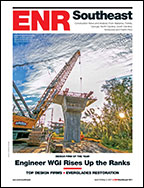Nevertheless, utility issues could have been worse: The team anticipated some 600 potential conflicts but ended up encountering fewer than 200, says Scott Cromack, ZOPB project director.
Across the three segments, approximately 2,000 workers are active on-site, accounting for more than $1 million in construction a day, says Cromack. "They work two shifts a day, more or less 24/7, on a six-days-per week schedule." However, with so much other construction occurring in the region, the competitive labor market has been a challenge, he adds, noting, "Our attrition rate is 10% a month—that's an issue."
From west to east and north of Houston, segment F-1 consists of about 12 miles of greenfield road that will connect U.S. 290 to state Highway 249. F-2 runs about 12 miles from Highway 249 to I-45, and segment G will take drivers about 15 miles from I-45 to U.S. 59 at I-69. To make its scope of work more manageable, the team "broke the project into $250-million construction segments," says Cromack. "We have three offices that function as if they are separate project sites." The F-2 project office colocates ZOPB team members with TxDOT project officials and quality-assurance team members. Moreover, segment G "is so big that we have two sub-offices for it," Cromack adds.
The project team also operates four pug mills, to mix sand and rock with cement; six concrete batch plants and a casting yard, says Cromack. "We even bought extra land to host a batch plant," he adds.
The casting yard, located near U.S. 59, turns out beams and panels around the clock, six days a week, to build the 120 bridges that comprise 4.3 million sq ft of concrete. Beams range in length from 45.6 ft to 138.6 ft; the largest weigh 118,000 lb. The deck panels are typically 8 ft wide and up to 9 ft, 7 in., long and weigh up to 3,600 lb. There are about 3,000 beams and more than 67,000 panels produced at the yard's six casting beds; the finished products are lifted by 50-ton gantry cranes onto tractor-trailers for delivery to the jobsite, says casting yard manager Tarso Gobbi.
Many of the bridges are at low elevation and span floodplains, notes Perantoni. "Throughout the alignment, it's a low-lying, slow-draining area," he says. "Water tends to stick around, and it finds its way through the creeks and bayous, eventually."
From a construction standpoint, that means, "when it rains, it puddles," notes Perantoni. "We have to make provisions for pumping water or establishing drainage before going into an area, even when it's light rain. And it rains consistently throughout the year. We've built detention ponds, parallel pipes along the road and directed water into creeks or large ponds through culverts and open ditches." According to TxDOT, the project also has the largest stream mitigation project in the U.S., at about 110,000 linear ft.
In just two years, ZOPB expects to complete by October 10 million cu yd of excavation, 11 million cu yd of landscaped embankment, 250,000 linear ft of storm drainage piping, 1.8 million sq yd of concrete paving, 1.2 million sq ft of retaining wall, 200,000 linear ft of drilled-shaft foundations to stabilize the roadways, 620,000 sq ft of sound walls and 110 million lb of reinforcing steel.
The team will not receive any project bonuses for early completion of all this, but it would face potential liquidated damages of $150,000 a day, says Cromack.
In the meantime, it appears future construction on the Grand Parkway will continue the alternative delivery trend. Last summer, the Texas Transportation Commission authorized a request for qualifications for the development, design, construction and potential maintenance of all or part of segments H, I-1 and I-2 as a design-build project.
The project includes segments H and I, which will run 37.5 miles from North U.S. 59/I-69 to I-10 East and will include one to two lanes in each direction, with limited frontage roads through Montgomery and Liberty counties. It also will complete the toll lanes on segment I-2, which runs 15.3 miles from I-10 East to state Highway 146. The estimated total construction cost is $1.2 billion.
Last October, TxDOT announced the short list of teams invited to submit a detailed proposal; they included: Fluor Balfour Beatty Williams Brothers LLC, Zachry-Odebrecht-Traylor Parkway Builders and Grand Parkway Infrastructure. "We anticipate receiving proposals this spring and have a target for conditional award in late 2015," says Lewis.







Post a comment to this article
Report Abusive Comment